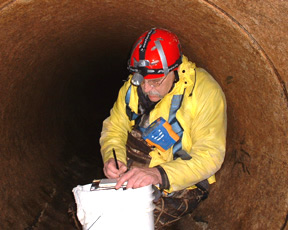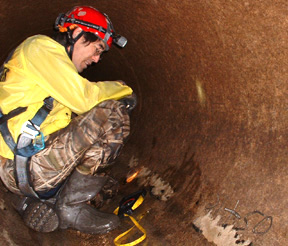Little Dell Dam Inspection
Outlet works inspection requires careful preparation and safety measures
March 22, 2005
|
This year the outlet works pipe was scheduled for inspection. The 42 inch in diameter Lower Conduit is approximately 1,360 feet long; and the 72 inch in diameter Upper Conduit is approximately 650 feet long. The reservoir level at the time of inspection was approximately 141 ft above the invert of the bulkhead intake.
Safety measures
As this inspection required confined space entry, safety manager Wes Ing toured the facility and reviewed the scope of work and entrance locations. With this information he prepared a hazard analysis and established a lockout/tag out procedure with the operating personnel at the Parley’s Water Treatment Plant and prepared a list of the necessary safety equipment that would be required for a safe entry. A safety tabletop exercise was conducted with the Salt Lake County Unified Fire Authority, the entry team, plant personnel and the safety manager to review entry procedures and the inspection plan.
As happens even on well planned endeavors, the entry team found the air quality unfavorable for the initial inspection try. With the addition of two ventilators from the Salt Lake County Unified Fire Authority, who was providing stand-by rescue capabilities, the inspection proceeded in the Lower Conduit. Likewise, ventilation through the 6-inch air vent for the Upper Conduit did not initially go as planned; however, the support team was able to supply suitable air into the conduit and the entry team proceeded with the inspection as planned.
Engineers Frank Hamilton and Bernard Mo made the inspections inside the conduits with the aid of carried air monitoring meters and 10-minute escape tanks. The air was checked for quality and for circulation using smoke tubes prior to entry for the inspection. No safety hazards were encountered during the inspection.
Findings
Overall the outlet piping was found to be in excellent condition with only minor items noted for follow-up monitoring during future inspections. In particular the Lower Conduit lining and valve seats were in very good condition with only slight evidence of normal wear and tear. The concrete lining showed no signs of abrasion or unusual wear that would require corrective action at this time. Leakage around the bulkhead gate was much less than anticipated for such a large structure.

